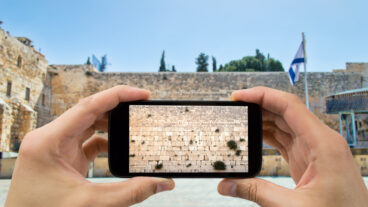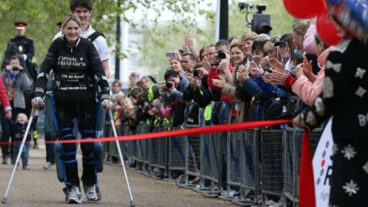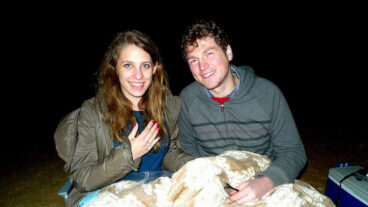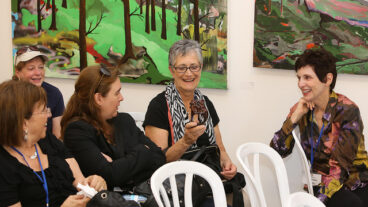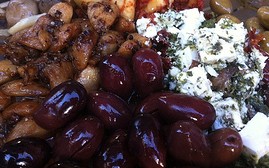Israeli airline El Al celebrates its 60th anniversary this fall. It’s been a long and interesting ride.This fall, El Al will mark 60 years in the air. The company’s maiden flight took place on September 28, 1948… to pick up the first president of the State of Israel Chaim Weizmann from Geneva and bring him to Israel. Few know that the original El Al insignia blazoned on the company’s first uniforms wasn’t a Star of David; it was a flying camel – a mascot of early Jewish aviators. In its 60 years, El Al has accumulated a stock of “you’ll never believe this” service stories – some are highly “unorthodox services” the company has provided in extraordinary times, and a number concern genuinely bizarre “service routes” that sound like an upscale fly-by-night take-off on Marc Chagall’s famous series of blissful floating lovers seemingly caught in mid-flight.
One winter, El Al looked into using some of the carrier’s fleet as flying movie theaters during slow periods. The idea never got off the ground as a commercial operation… perhaps because the unorthodox flight plan – simply going in circles over the Med – did not qualify moviegoers for duty-free privileges.
Some of El Al’s perks are industry firsts. The most outstanding one to date was inaugurated in 2002 on behalf of a wealthy New York couple who visit Israel at least four times a year, each time bringing their two cats with them. The airline decided to allow small dogs, cats and birds, who indeed had tickets – $89 one-way from New York, Chicago or Miami and $98 from Los Angeles – to collect frequent flyer miles and gain a free trip along with their owners.
Anyone for Paris?
Once upon a time, cynics said “El Al” stood for “Every Landing Always Late.” But in the early 1990s, El Al found itself plagued by a chronic case of corporate jet lag due to passengers’ last-minute duty-free shopping sprees before boarding. At one point, fed up with having to hunt down bargain-hunters, an El Al plane took off on time – leaving seven tardy passengers in the lurch. When questioned by the press, a company official explained: “It’s out of the question that every morning, on almost all flights, we act as if we were a taxi outside the Tel Aviv Central Bus Station – yelling ‘Paris, Paris, Who is going to Paris?’ before taxiing away.”
Speaking of Paris – in 1990, on one El Al plane bound for the French capital, an asthmatic passenger found he had forgotten his medicines in a Tel Aviv hotel room. While there were emergency medical supplies on board, according to news reports, after consultation with El Al’s doctors, the pilot was instructed to fly at 31,000 rather than 43,000 feet – despite the additional fuel consumed at lower altitudes – in order to maintain optimal conditions for the passenger.
In terms of conventional cargo, in 1987 El Al was flying high, grabbing ninth place among trans-Atlantic cargo carriers. At the time, the company’s ads sported a picture of a “flexible” cargo plane with the head of a giraffe and the body of an elephant bulging out of the roof of the cabin, under the caption – “You won’t believe what we’ll do for your cargo.” In 1987 a quarter of the company’s revenues came from carrying almost anything. But one contract was definitely not El Al’s dish: Approached about transporting Canadian ham to Europe – still on the hoof – El Al feared a negative reaction among its religious clientele, and rejected the lucrative offer, hams down.
Indeed, religious clientele constitute a third of the passengers flying El Al. Beyond the sweeping demand that the company refrain from flying on Shabbat, in June 1987 El Al agreed not to fly over the Temple Mount – until the coming of the Messiah. The airline then introduced special plastic liners for “flying coffins” that haredi elements demanded to prevent “mid-flight leakage of the “tum’a” (unclean spirits of the dead) in the presence of Kohanim. And in 2002, a haredi cohen asked to be allowed to zip himself up in a body bag during take-off to avoid close encounter with the tum’a purported to be rising from the Holon Cemetery located directly in the takeoff path from Ben-Gurion Airport. The request was turned down, but air control agreed to detour all flights slightly to avoid flying directly over the cemetery.
One case of “special handling” involved some very special hand-baggage: In a race against time, an American Red Cross representative collected 572 blood samples from Jews of Lithuanian lineage at blood banks in Carmiel near Haifa and the Sheba Medical Center outside Tel Aviv. Packing the contents in an insulated picnic box, the American sped to catch a 2 am El Al flight back to the US – in the hopes of finding a match for a 20-year-old woman badly in need of a bone marrow transplant.
From $4,500 to $60,000 in one flight
One of the most unforgettable humanitarian gestures to which El Al was a part took place on Flight 316 from Tel Aviv to London: Among the passengers was four-year-old Moran Kadosh, on her way to London for a liver transplant. The child was accompanied by a doctor and her parents – who had a mere $4,500 in their pockets to finance surgery. When the child’s plight became known to fellow passengers and El Al flight employees, they organized a spontaneous collection at 35,000 feet. The captain announced over the public address system that Moran’s life was in danger. By the time the jumbo landed at Heathrow, 400 passengers and crew had gathered the $60,000 needed to pay for the transplant.
Another unforgettable episode centered on a volatile pilgrim from Latin America. While politics can make strange bedfellows, the lady in question presented a genuine enigma: Halfway to Tel Aviv, she stripped to the buff, telling a bewildered El Al steward – “I want Shamir! – referring to then-prime minister Yitzhak Shamir. In another case, a passenger got up in mid-flight, walked to the front of the plane and sought to open the door to the cockpit. Diplomatically detained by a cabin attendant who asked where he was going, the passenger replied that he “only wanted to step out for a breath of fresh air…”
In September 1970, the Popular Front for the Liberation of Palestine skyjacked four airplanes. Few know there was a fifth target – an El Al flight, where the midair attempt was foiled by the pilot, who plunged the aircraft into a 14,000-foot nosedive, throwing the two armed terrorists for a loop, allowing passengers and crew to overpower the pair, including a traveler purported to have clobbered the male assailant over the head with a whiskey bottle before the air marshal took over.
Going in the other direction, in the 1980s a group of Greek pilgrims arrived at Ben-Gurion Airport after an Easter pilgrimage carrying 20 burning candles in glass containers they planned to take on board as carry-on baggage. The candles had been lit in the Church of the Holy Sepulcher and they wanted to take the “holy flame” home with them. Not wanting to disappoint the passengers, the cabin crew agreed to stow one lit candle in a galley stove and return it to the group after landing.
While efforts to go the extra mile may raise questions whether any air carrier can hold a candle to El Al, the ultimate case of going out of the way for passengers was Operation Solomon: the historic June 1990 airlift of 15,000 Ethiopian Jews to Israel in 24 hours, using IDF and El Al planes. El Al made aviation history… and The Guinness Book of World Records, for transporting 6,500 passengers in 10 aircraft.
Printed by courtesy of The Jerusalem Post.





